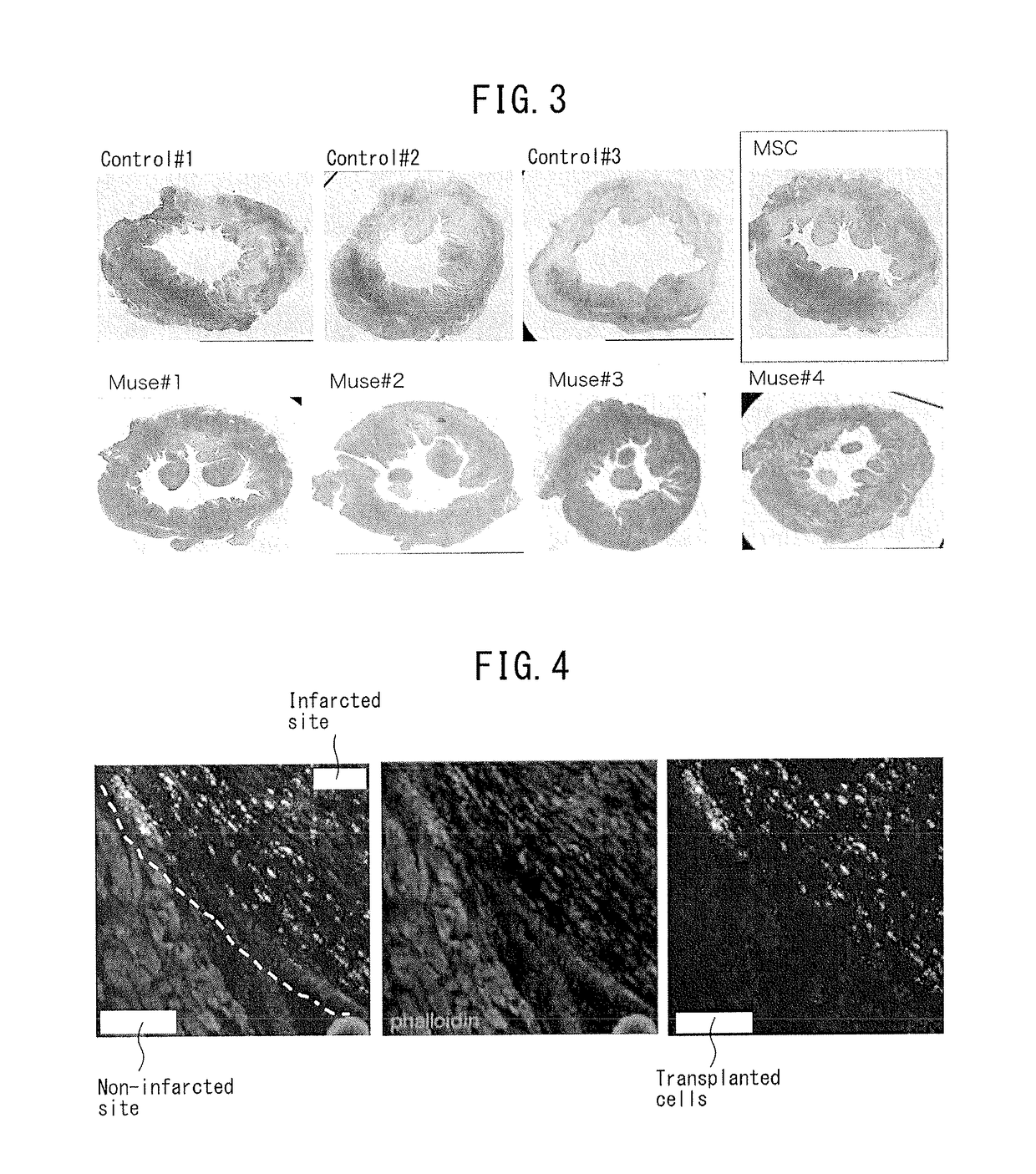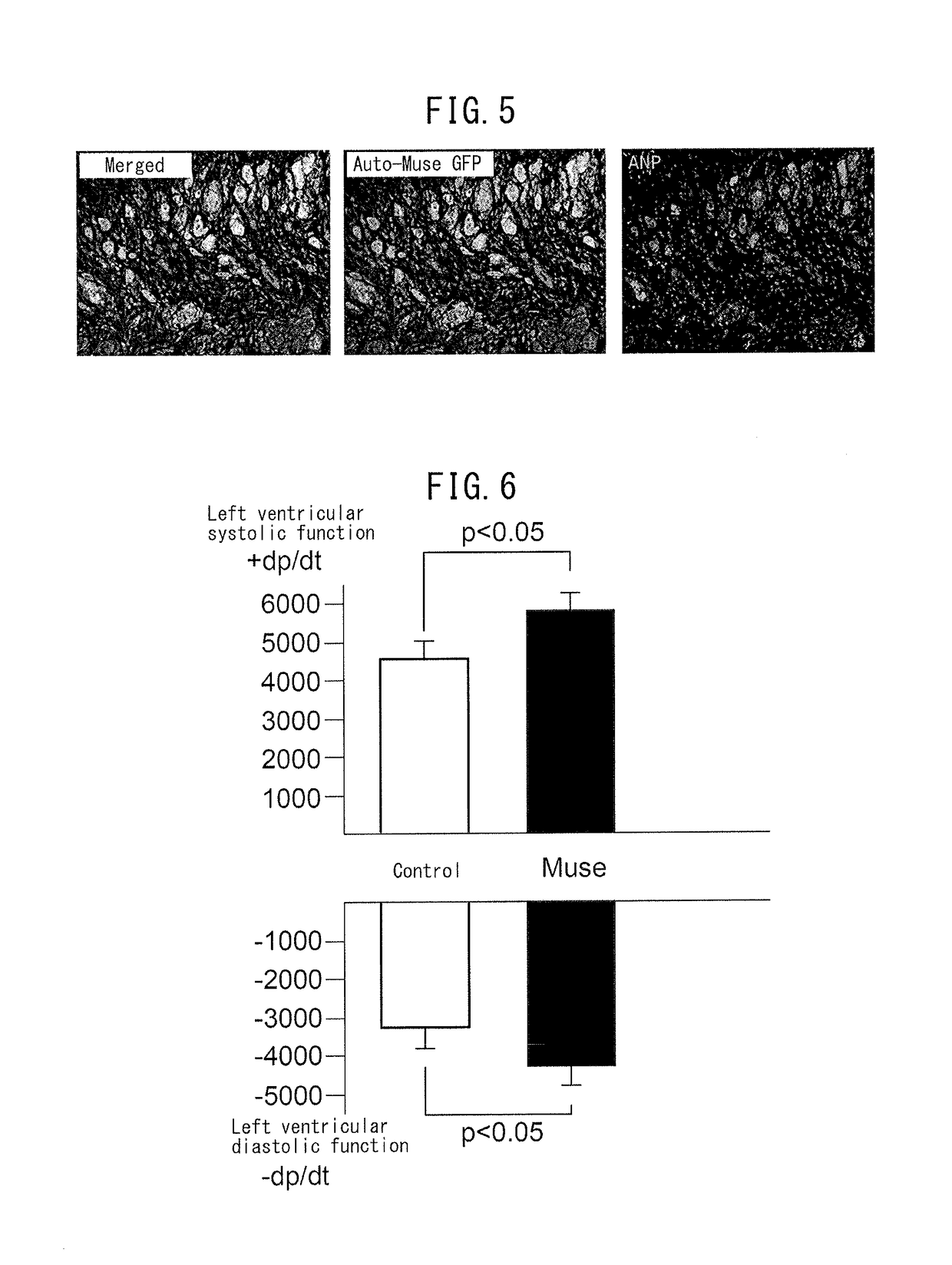Pluripotent stem cell that induces repair and regeneration after myocardial infarction
a stem cell and myocardial infarction technology, applied in the field of regenerative medicine, can solve the problems of recurrent myocardial infarction or accompanying heart failure, poor prognosis, and inability to achieve recanalization, so as to reduce the size of the myocardial infar
- Summary
- Abstract
- Description
- Claims
- Application Information
AI Technical Summary
Benefits of technology
Problems solved by technology
Method used
Image
Examples
example 1
Production of Rabbit Model of Myocardial Infarction
[0078]The protocol for experimentation using rabbits in the present example was approved by the ethics committee regarding animal experimentation of Gifu University, and was carried out in line with “Guidelines for the Care and Use of Laboratory Animals” (1996 revised edition) issued by the U.S. National Institutes of Health (NIH). More specifically, the procedure was as described below. First, Japanese white rabbits (body weight: approx. 2 to 3 kg / animal) were anesthetized using sodium pentobarbital at 30 mg / kg. The rabbits were continuously subjected to analysis of arterial blood gas, and ventilation conditions were suitably adjusted so that arterial blood gas was maintained within the physiological range. The left carotid artery and jugular vein were cannulated followed by monitoring of arterial pressure. After performing left thoracotomy at the third intercostal space, the heart was exposed and the center of the outer anterior s...
example 2
Reduction Effect on Myocardial Infarct Size of Transplantation of Muse Cells
(1) Preparation of Muse Cells
[0079]Bone marrow cells were collected from rabbits (body weight: approx. 2 kg to 3 kg / animal) and SSEA-3-positive cells (Muse cells) were isolated using FACS. More specifically, Muse cells were isolated in compliance with the method described in International Publication No. WO 2011 / 007900 relating to isolation and identification of human Muse cells. Furthermore, the Muse cells used for transplant were derived from bone marrow cells of rabbit individuals in which myocardial infarction had been induced, adhesive mesenchymal cells were cultured from bone marrow, and lentivirus-GFP was introduced into the cells after allowing the cells to proliferate. Muse cells or a cell population containing Muse cells labeled with GFP were isolated with FACS to obtain cells double-positive for GFP and SSEA-3. Subsequently, the cells were adjusted to a prescribed concentration and returned to the...
example 3
Differentiation of Muse Cells in Cardiac Tissue
[0085]A study was made as to whether or not the reduction of infarct size attributable to Muse cells observed in Example 2 was the result of differentiation by Muse cells into myocardial cells. First, Muse cells (5×105), inserted with a gene so as to express green fluorescent protein (GFP), were injected into a rabbit model of myocardial infarction through an ear vein. Tissue sections were prepared in the same manner as Example 2 and the tissue was observed using fluorescent dyes for each type of tissue stain (FIG. 4). As is shown in the left panel of FIG. 4, the white broken line indicates a boundary line between an infarcted portion and a non-infarcted portion, with the portion above and to the right of the boundary line indicating infarcted sites and the portion below and to the left of the boundary line indicating non-infarcted sites. The center panel depicts the results of staining myocardial cells red with rhodamine-phalloidin sta...
PUM
| Property | Measurement | Unit |
|---|---|---|
| Time | aaaaa | aaaaa |
| Fraction | aaaaa | aaaaa |
| Pressure | aaaaa | aaaaa |
Abstract
Description
Claims
Application Information
 Login to View More
Login to View More - R&D
- Intellectual Property
- Life Sciences
- Materials
- Tech Scout
- Unparalleled Data Quality
- Higher Quality Content
- 60% Fewer Hallucinations
Browse by: Latest US Patents, China's latest patents, Technical Efficacy Thesaurus, Application Domain, Technology Topic, Popular Technical Reports.
© 2025 PatSnap. All rights reserved.Legal|Privacy policy|Modern Slavery Act Transparency Statement|Sitemap|About US| Contact US: help@patsnap.com



